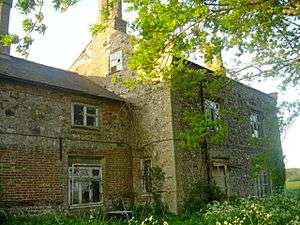Winnold House
| Grade II listed building | |
|---|---|
| Location: | Winnold House Wereham King's Lynn Norfolk United Kingdom |
| Built/Founded:: | 1199 |
| Architectural styles: | Vernacular |
| Designated as a LB: | 9 July 1951[1] |
Winnold House, formerly the Benedictine Priory of St. Winwaloe, is a country house near Wereham in Norfolk, England. Coordinates: 52°36′26″N 0°29′30″E / 52.6073°N 0.4917°E The house is constructed from the remaining fragments of a former Benedictine priory. The priory was founded in 1199 and was dissolved in 1321. It was demolished in 1539, and the serviving fragments where incorporated into a house sometime in the 17th century, and was later rebuilt in the mid-19th century.[1]
History
The priory of Wereham was founded by the earls of Clare during the rain of Richard I in the late twelfth century. It was dedicated to Saint Winwaloe (a.k.a. Saint Guenolo), a British saint who flourished about 550 CE. in the sixth century, and whose body was enshrined in the abbey of Monsterol in the diocese of Amiens in France, where he lived.
The earliest extant deed of the priory is one of 1199, whereby L., prior of Saint Winwaloe, with the consent and advice of his brother, Remigius, abbot of Monsterol, granted a toft and eleven acres to Robert de Stradesete. In 1270 there was an exchange of lands in Wereham between the abbot and convent of Wereham and the abbot and convent of Saint Salvin's of Monsterol, acting on behalf of the priory of Saint Winwaloe. At the time, the priory held lands in three Norfolk parishes, with the annual value of £7.[2]
In 1321, the abbot and convent of Monsterol sold the priory to Hugh Scarlet of Lincoln, who conveyed it to Elizabeth de Clare, the foundress of Clare College in Cambridge. In 1336 she conveyed the manor and lands of the priory to the abbot and convent of Dereham on the condition that he would find a chaplain to say daily mass in the chapel of Saint Winwaloe for the souls of Gilbert, earl of Clare, and of Elizabeth and her ancestors and heirs forever. Ten years later Elizabeth granted the custody of the priory to her well-beloved friend, John de Brauncestre.
At the dissolution the manor of Winwaloe, late belonging to the abbey of Wereham, came to the crown, and was granted in the first instance to Thomas Guybon and William Mynn.
Architecture
The remains of the priory can be seen on many of the walls of the house.[3]
Design
The priories stonework is ashlar and coping, and the roof is composed of slate. South front of 2 storeys in 2 bays. 20th-century door and porch to left. Windows are 3-light cross casements under re-used square hoods on head stops. Triangular stops to first floor casements. Moulded ashlar eaves cornice below gabled roof with 19th-century internal end stacks carrying twin octagonal gault brick flues. Gable ends on kneelers. East wall with remains of external stack, flat buttress to left and clasping buttress to right, the latter being the remains of a 12th-century pier: single shaft to left and on north face multi-shafted above set-off. 2 set-offs to east gable wall, remains of one C12 lancet and C17 attic window. North elevation with 12th-century string course at first floor, flat central buttress and remains of annulated engaged column to right. 3 inserted casements and door. Dentil eaves cornice. To west an early C19 brick and ashlar extension of 2 storeys. 19th- and 20th-century casements, gabled slate roof and ridge stack right of centre with paired octagonal gault brick flues.[1]
Notes
- 1 2 3 "Winnold House, Wereham". British Listed Buildings. Retrieved 7 October 2010.
- ↑ 1291 taxation documents.
- ↑ Wilkin, Rosie (2003). "St. Winwaloe's Priory, near Wereham". The Rule of St. Benedict. Retrieved 9 October 2010.
References
- Doubleday, Herbert Arthur (1906). "Religious Houses: The Priory of St. Winwalloe, Wereham" (PDF). A History of the County of Norfolk. 2. Institute of Historical Research. pp. 465–466. Archived on 20 December 2008. Retrieved 7 October 2010.
- Blyth, William (1863). "Chapter II: Fyncham, in the 12th and 13th Centuries". Historical Notices and Records of the Village and Parish of Fincham in the County of Norfolk (PDF). Thew & Son. p. 22. Retrieved 7 October 2010.
